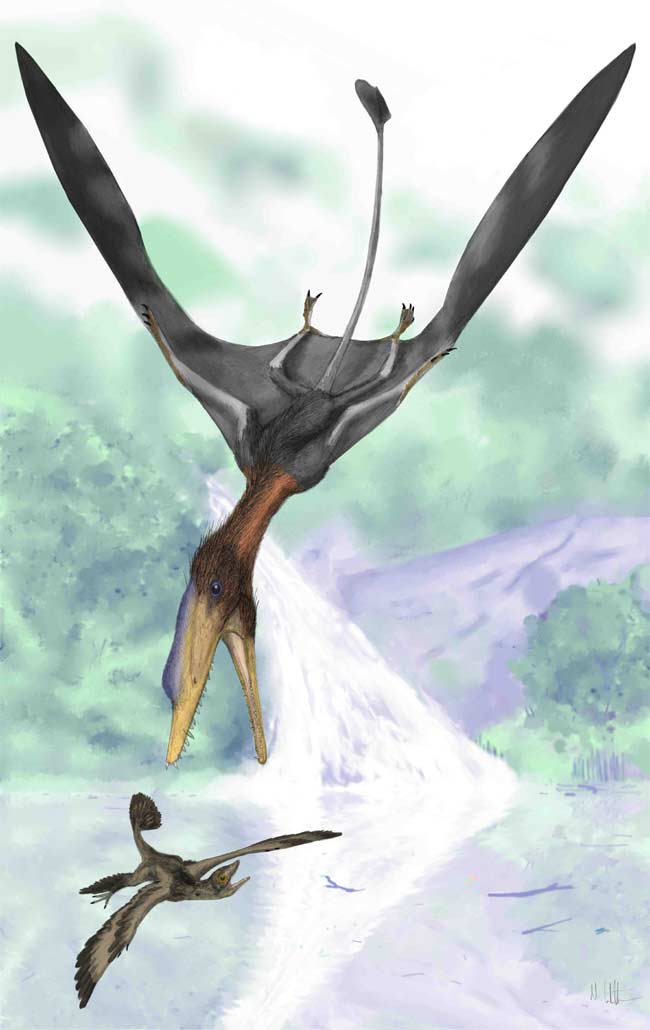Flying Reptile May Have Snatched Dinosaurs in Midair

A crow-sized reptile sporting a lengthy tail likely soared through the skies some 160 million years ago, snatching feathered dinosaurs and tiny flying mammals from the air, suggest fossils of a newly identified pterosaur.
While paleontologists can't go back in time to watch the in-flight meal capture, the reptile's fossils, discovered recently in China's Liaoning Province, left behind compelling clues, the researchers say this week in the journal Proceedings of the Royal Society B: Biological Sciences.
Now called Darwinopterus modularis, the reptile is an evolutionary gap-filler between primitive long-tailed pterosaurs and their descendants, advanced short-tailed pterosaurs that reached enormous sizes.
Such "winged lizards," as their name suggests, are thought to have dominated the skies from more than 200 million years ago until the mass extinction event 65 million years ago that wiped them out along with most dinosaurs and many other plants and animals.
Mix and match
The new find, Darwinopterus, sported a long tail, reaching about 40 percent of its body length and probably used for stability in flight, like primitive pterosaurs. But the beast was also equipped with a head and neck identical to advanced pterosaurs. And it had a single opening in front of the eye (rather than two as in primitive pterosaurs), which marks the fusion of the nasal opening and the so-called antorbital opening, the purpose of which is unclear.
The combination of its features also point to an aerial predator, the researchers say. These include: sharp teeth for meat-eating, a skeleton suggesting the reptile "was a slow and clumsy mover on the ground," and a flexible neck, suggesting hawk-like abilities to catch and kill other flying creatures, said lead researcher Lü Junchang of the Chinese Academy of Geological Sciences in Beijing.
Sign up for the Live Science daily newsletter now
Get the world’s most fascinating discoveries delivered straight to your inbox.
Naïve flyers at the time could have made for easy pickings. "The exact flight ability of the feathered dinosaurs is still unclear, but it was probably restricted to gliding or simple flapping and gliding," Lü told LiveScience. "Thus, they were likely to be far less competent and effective in the air than Darwinopterus, which presumably caught its prey in its jaws either in midair, or possibly by picking them off branches or fronds as it swept past, much as bats glean insects from trees and bushes today."
Lü and colleagues do caution that further analyses are needed to firm up the pterosaur's diet and feeding mechanics.
Evolution in modules
The fossil find could also speak to the mechanics of macroevolution. "Darwinopterus provides some clear evidence for a modular form of evolution, which might help to explain how some groups manage to change so quickly at certain points in their evolutionary history," Lü said.
Here's how Lü and colleagues suggest such modules, or groups of features, may have evolved in pterosaurs, based on the intermediate stature of Darwinopterus: The head and neck likely evolved first, while the rest of the body (including the tail) evolved later.
"We speculate that evolution of the head and neck was related to new adaptations to feeding, such as the hawk-like lifestyle proposed for Darwinopterus," Lü said.
The evolution of the body, such as the shortening of the tail and lengthening of the wrist, may have enabled pterosaurs to move more efficiently on the ground and perhaps in the air as well, Lü said.
- Avian Ancestors: Dinosaurs That Learned to Fly
- Dinosaur News, Images and Information
- Images: Drawing Dinosaurs
Jeanna Bryner is managing editor of Scientific American. Previously she was editor in chief of Live Science and, prior to that, an editor at Scholastic's Science World magazine. Bryner has an English degree from Salisbury University, a master's degree in biogeochemistry and environmental sciences from the University of Maryland and a graduate science journalism degree from New York University. She has worked as a biologist in Florida, where she monitored wetlands and did field surveys for endangered species, including the gorgeous Florida Scrub Jay. She also received an ocean sciences journalism fellowship from the Woods Hole Oceanographic Institution. She is a firm believer that science is for everyone and that just about everything can be viewed through the lens of science.









